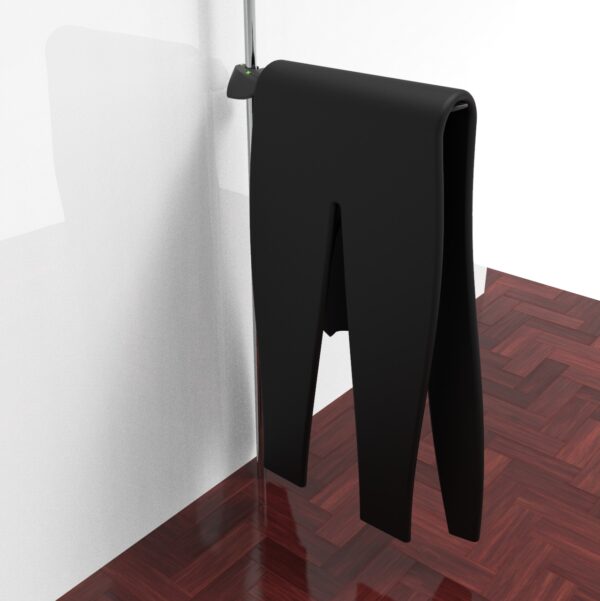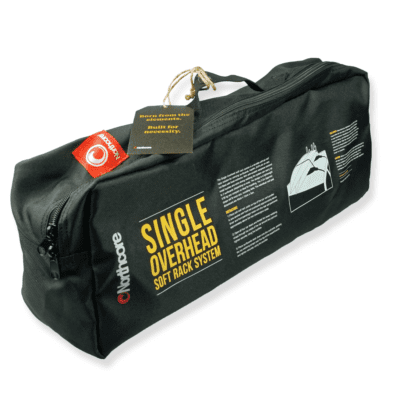XRail – Wetsuit and wetgear hanger
€29.95
XRail – Wetsuit (-accessorie) hanger
Eco-friendly – Made from 100% recycled plastic.
Travel ready – Lightweight and easy to pack.
Reliable – Can support up to 5kg.
Pegless hanging – Includes a bungee cord system for hanging your hood, gloves and boots.
Crease-free – Ergonomic design ensures wetsuit won’t crease at the waist.
Practical – Take your wetsuit and wetgear on and off with ease.
Convenient – Can be affixed to multiple surfaces in your home, shed, garage or on your boat.
| Weight |
.35 kg |
| Dimensions |
50 × 7.5 × 6 cm |
In stock
Description
XRail – Wetsuit and wetgear hanger
XRail by EXIT, the secret to making your wetsuit, hood, gloves and boots last longer.
XRail is a revolutionary new hanger that eliminates the strain traditional hangers put on the neck and shoulders of a wetsuit when drying. So new wetsuits stay feeling new and old wetsuits keep kicking.
Who are we?
We’re people just like you…
We love the ocean, the rivers, the lakes and the beaches.
We’re fanatical about watersports and water activities.
We value quality, precision and affordability.
We appreciate the little things, but we also dream big.
We are conscious of our environmental footprint.
We look beyond the status quo to solve common problems.
We believe in getting out and living.
We started with an idea to create a brand and products that inspire action sports lovers to get out and live.
We quickly realised we were taking on more than we could chew and so we refined Exit back to support watersport’s people.
With our first product the XRail we now start our journey in providing products that help our customers and the environment.
Using eco-friendly materials that are made to last with an emphasis on quality, affordability and practicality.
So we can enjoy doing the things we’re passionate about for longer.
Brand
XRAIL SURF ACCESSORIES
XRail by EXIT, the secret to making your wetsuit, hood, gloves and boots last longer.
XRail is a revolutionary new hanger that eliminates the strain traditional hangers put on the neck and shoulders of a wetsuit when drying. So new wetsuits stay feeling new and old wetsuits keep kicking.

THERE ARE MANY ASPECTS TO SURFBOARD SELECTION THESE ARE THE POINTS TO CONSIDER
LENGTH
Typically surfboards are measured in inches. The length is measured from the nose to the tail. Choosing the length of the surfboard is dependant on your size (weight, height), board type and waves conditions you wish to use the board for.
WIDTH
The widest point of the surfboard is measured from rail to rail. Generally the wider the surfboard the more stable the board, while a board with smaller width maintains better speed and performance.
BOARD THICKNESS
Surfboard thickness is measured from the top deck to the bottom. The thickness again has a bearing on the board’s performance. Professional surfers will tend to go for the thinner boards as they are lighter and offer better performance.The thicker boards are stronger and because there is more foam under the surfer the boards are more stable.
ROCKER
The bottom curve of a surfboard. Generally the more rocker the surfboard has the more loose (manoeuvrable) the surfboard will be. Where the flatter rocker surfboards will be faster, although they will lack the looseness. The nose is the tip of the surfboard, the nose can vary in shapes and size. Basically the thinner the nose the more response the board will perform, while wider noses are better for stabilization.
STRINGER
Used to increase the strength of a surfboard, a stringer (normally made from wood) runs down the length of a surfboards (typically in the centre of the board from the tip of the nose to the tail).
Boards built with Epoxy, Carbon Fibre and soft boards generally don’t have stringers.
FINS
Generally heavier surfers require larger fins to hold the waves better. Although if you prefer to ride a looser (less hold in the waves), smaller fins would be a better option.
FIN CONSIDERATIONS
Fin configurations have an effect on the ways your surfboards perform.
The following are some of the more common fin configurations.
SINGLE FIN
The single fin was the original fin configuration for surfboards. Based on the idea of the sailboat keel. Single fins are added stabilization and control on the powerful, larger waves, although lack manoeuvrability
TWIN FIN
Are great for small waves, being fast and manoeuvrable, but when put into tight spots on larger waves, they become hard to control. Popular with Fish surfboards.
THRUSTER 3 FIN
Widely recognized as the standard fin configuration, the thruster answers the shortcomings of the single fin and the twin fins configurations.
The thrusters give you stabilization, control and manoeuvrability in all types of surfing conditions.
This concept was the brainchild of Australia’s Simon Anderson
QUADS 4 FINS
With four fins in the water, Quads boasts an extraordinary amount of holding power in larger surf.
You may think that having four fins would sacrifice speed by creating more drag, but this is not the case.
The both sets of fins are working together on the rail, which makers believe they creates less drag than a board with a centre fin.
The manoeuvrability isn’t sacrificed either, with fins directly under your back foot, the quads are very responsive.
KEEL
Similar setup to the Twin Fin, although smaller (low profile) fins are generally placed wider (closer to the rails) on the surfboard.
Popular with Fish and Egg / Retro surfboards.
Heeft u hulp nodig bij uw aankoop? Neem dan gerust contact met ons op
+3170 201 5153
info@noordzeeboardstore.nl
Contact formulier











